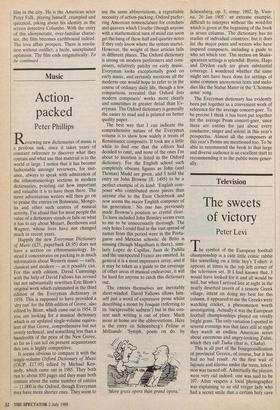Music
Action-
Peter Phillips
Reviewing new dictionaries of music is a perilous task, since it takes years of constant reference to discover what they contain and what use that material is to the world at large. I notice that it has become fashionable amongst reviewers, for inst- ance, always to speak with admiration of the ethnomusicology sections in modern dictionaries, pointing out how important and valuable it is to have them there. The more adventurous writers will then go on to praise the entries on Botswana, Mongo- lia and other such centres of musical activity. I'm afraid that for most people the value of a dictionary stands or falls on what it has to say about Mozart, Beethoven and Wagner, whose lives have not changed much in recent years. Happily the new Everyman Dictionary of Music (£25, paperback £8.95) does not have a section on ethnomusicology. In- stead it concentrates on packing in as much information about Western music — early, classical and modern — as it possibly can. For this sixth edition, David Cummings with the help of David Fallows has revised but not substantially rewritten Eric Blom's original work which culminated in the third edition of the Everyman dictionary in 1958. This is supposed to have provided a 'dry run' for the fifth edition of Grove, also edited by Blom, which came out in 1954. If you are looking for a musical dictionary which is an updated single-volume equiva- lent of that Grove, comprehensive but not overly technical, and something less than a hundredth of the price of the New Grove, so far as I can tell on present acquaintance this one is highly competitive. It seems obvious to compare it with the single-volume Oxford Dictionary of Music (OUP, £17.95) edited by Michael Ken- nedy, which came out in 1985. They both run to about 850 pages and they must both contain about the same number of entries — 11,000 in the Oxford, though Everyman may have more shorter ones. They seem to use the same abbreviations, a regrettable necessity of action-packing, Oxford prefer- ring American nomenclature for crotchets and quavers which I loathe (though anyone with a mathematical turn of mind can soon get the hang of these half and quarter notes If they only know where the system starts). However, the weight of their articles falls in different places. The Oxford dictionary is strong on modern performers and com- posers, relatively patchy on early music. Everyman looks exceptionally good on early music, and certainly mentions all the moderns one would hope to refer to in the course of ordinary daily life, though a few comparisons revealed that Oxford lists modern composers' works more clearly and sometimes in greater detail than Ev- eryman. The Oxford dictionary is generally the easier to read and is printed on better quality paper.
The best way that I can indicate the comprehensive nature of the Everyman volume is to show how widely it treats of Renaissance composers. It took me a little while to find one that the editors had decided to omit, and none of the ones I'm about to mention is listed in the Oxford dictionary. For the English school such completely obscure figures as John (and Thomas) Mudd are given, and I hold the entry on John Browne (fl. 1495) to be a perfect example of its kind: 'English com- poser who contributed more pieces than anyone else to the Eton Choirbook and now seems the major English composer of his generation.' No one has previously made Browne's position so crystal clear. To have included John Brimley seems even to me to be unnecessarily thorough. The only holes I could find in the vast spread of names from this period were in the Portu- guese and Mexican schools: de Brito is missing (though Magalhaes is there), simi- larly Lopez de Capillas, Juan de Padilla and the unexpected Franco are omitted. In general it is a most impressive array, and if It may be taken as a guide to the coverage of other areas of musical endeavour, it will be hard for anyone to catch this dictionary out.
The entries themselves are inevitably short-winded. David Fallows allows him- self just a word of expressive prose whilst describing a motet by Josquin (referring to its 'inexpressible sadness') but in this con- text such writing is out of place. Much more at home are the abbreviations. Here is the entry on Schoenberg's Pellias et Milisande: `Symph. poem on do. by 'More gross opera than grand opera. Schoenberg, op. 5, comp. 1902, fp. Vien- na, 26 Jan 1905': an extreme example, difficult to interpret without the word-list which is given at the beginning of the book in seven columns. The dictionary has no studies of individual countries; but it does list the major poets and writers who have inspired composers, including a guide to who set which text. The section on Shake- spearean settings is splendid: Byron, Hugo and Dryden each are given substantial coverage. I wondered whether the same might not have been done for settings of some common anonymous texts and melo- dies like the Stabat Mater or the l'homme arme' song.
The Everyman dictionary has evidently been put together as a convenient work of reference for the average concert-goer. To be precise I think it has been put together for the average Prom concert-goer, since there are entries for just about every conductor, singer and soloist in this year's prospectus. Almost all the composers at this year's Proms are mentioned too. To be able to recommend the book to that large and diverse audience is an excellent start to recommending it to the public more gener- ally.














































 Previous page
Previous page